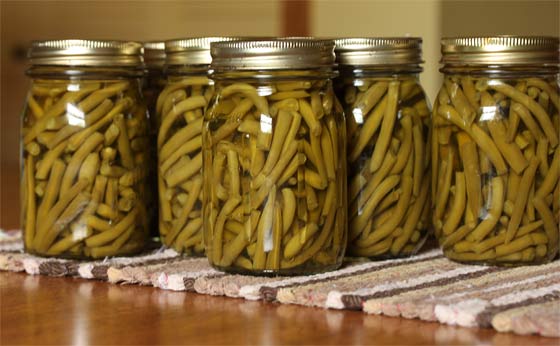Home Canning Tips | Lessons Learned

Canning Foods at Home | Tips
The following is a list of tips for home canning. Feel free to add your own in the comment section below.
Water-bath versus Pressure Canner
A water-bath canner should only be used for high acid foods such as fruits, pickles, jams & jellies. A pressure canner MUST be used for low acid foods including vegetables and meats for food safety (higher pressure = higher cook temperatures to eliminate dangerous toxins).
Large Canning Jars
Avoid using canning jars larger than a quart. Home canning technology cannot guarantee that larger quantities will be sufficiently heated through for enough time (food in the center of a large jar may not get hot enough for food safety).
Jar Rim Check
Run your finger over the top of the canning jar rim and check for nicks. Even the tiniest nick makes the jar unusable for canning because a nicked jar rim won’t seal reliably.
Keep a binder with your notes
Write hand written notes on what you’ve done, recipes used, etc. It all helps when you refer to it the next time you are home canning.
For A Good Seal…
Wipe the top of the jar with a cloth dabbed in vinegar. This will remove any gunk to ensure a good seal.
Lids soaked in hot water
It is currently recommended not to boil the lids. Rather, heat water in a shallow pan just prior to boil. Soak lids to soften the seal.
Remove Rings After Canning
Optionally, some people do this. After the jars have cooled and the lids have sealed (popped), remove the rings. This will avoid the possibility of rust developing on the jar & threads. It will also reveal if a jar lid loses its seal during storage and pops open (health hazard). Whereas a ring threaded over the lid will prohibit that visual observation until it’s actually opened for use.
Stacked Jars | Storage
Use original boxes that the jars came in. Older cases came in nice boxes. Newer cases now are only half a box (the bottom half – while the top is plastic wrapped). Or stack jars individually but with dividers in-between layers. You might use cardboard for this.
Labels and Dates
Use a strip of artists tape on the box to label (sharpie) what’s inside, and the month/year. Artist tape removes easily for the next batch, which may be different ingredients. We also sharpie the month/year on the lid of each jar.
Opening The Pressure Canner
Wait until it cools and pressure reaches “0”. NEVER ‘release’ the pressure from a pressure-canner, even slightly, the contents inside the Jars will boil from the pressure change and ooze the contents past the Lid/Ring making for failed seals 99% of the time.
Tightening The Rings
Do not over tighten the rings, over-tight rings will make the jar hold the pressure that needs to be released during Pressure Canning, again causing failed seals. Adjust ring till it first bottoms against the lid, then turn 1/3 turn more. That’s it. There’s a great tool for this, which we have in our canning toolbox:
Wash / Wipe Jars and threads after cool down
I have found that some foods may leave a residue on the threads and outside the jar after pressure canning. So after they’ve cooled, I remove the rings and wipe down the whole jar with a wet cloth soaked mildly with soap. Wait until dry before replacing rings.
Pressure Canning Tomatoes
The USDA has classified tomatoes as low-acid for canning, and is currently recommended to pressure can rather than boiling water bath method. With that said, historically, people have used the water-bath method for decades. Personally, I pressure can my tomato sauce.
Only can foods that are in good condition
In other words, don’t try to can any food that’s “off”, or on the verge of going bad. It will ruin your batch.
Don’t place canning jars directly on bottom of cooker
Place a wire rack or the standard canning-pot metal disk on the bottom of your canner. Otherwise the jars might break from direct contact with high heat.
Don’t be afraid of canning
It’s perfectly safe and easy. The more you do it, the simpler it seems. Just follow the recipes from well known sources. The most well known and reliable canning reference is the Ball Blue Book . I also reference the following guide, Complete Guide to Home Canning by the USDA .
Another popular reference guid is this one:
Ball Complete Book of Home Preserving
The least expensive, yet good quality pressure canner:
Presto 23-Quart Pressure Canner and Cooker
Continue reading: The All American Pressure Canner is The Best
